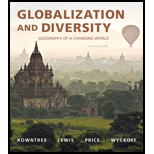
The reason behind Central Asia containing such large lakes and the reason behind many of these lakes threatened so severely.
Answer to Problem 10.1R
The Central Asia has numerous large lakes because of the geomorphology of the region. Majority of the region is composed of basins surrounded by mountainous regions. The lakes are threatened because of uneven precipitation and increased irrigation, leading to a shallowing of the lakes and a corresponding increased salinization.
Explanation of Solution
The physical geography of the Central Asia is characterized by mountains and high plateaus in the southeastern and south-central regions, steppes (grassland plains) in the north and the desert basins in the central and the southwestern regions. Most of the regions in central Asia is characterized by plains and basins. This lowland zone contains landscapes such as desert belt in central region and a strip of semiarid steppes in the north. This region contains numerous lakes because it contain basins interspersed between the high mountain ranges.
The typical environmental problems of arid environments affect the region such as desertification (the spread of deserts resulting from poor land-use practices), salinization (the accumulation of salt in the soil), and desiccation (the drying up of lakes and wetlands).
Aral Sea Destruction: Aral Sea is located between Kazakhstan and Uzbekistan. The Aral Sea is actually a lake. The destruction of this lake is one of the 20th century’s great environmental tragedies. The lake’s only sources of water are the Amu Darya and Syr Darya rivers, which originate in the Pamir Mountains. These rivers have been used extensively for irrigation by diverting water from the lake. With diversion, as the river flow reduced, the shallow lake began to recede and become more saline. The destruction of the Aral Sea resulted in cultural, economic, and ecological damage. In 2014, the southeastern basin of the Aral Sea became completely dry for the first time in 600 years. The efforts to save the lake have been most successful in the northern remnant of the lake.
Other Fluctuating Lakes: Western Central Asia contains many large lakes without draining to the ocean as it forms in the lowland basins bounded by mountains and humid regions. Lake Balqash, world’s 15th largest lake, became small and salty in the past several decades. The Caspian Sea, the world’s largest lake, receives most of its water from the Ural and Volga rivers in the north due to extensive irrigation of lower Volga basin and the flow of water to the Caspian has been diverted, leading to lower water levels and increased salinity. Recently, the water levels in the Caspian Sea is increasing due to high than normal precipitation, which is causing flooding problems. Then again, the lake began to shrink by half a meter. However, the lake is most threatened by pollution from oil industry rather than changes in size of the lake.
Want to see more full solutions like this?
Chapter 10 Solutions
Globalization and Diversity: Geography of a Changing World (5th Edition)
 Applications and Investigations in Earth Science ...Earth ScienceISBN:9780134746241Author:Edward J. Tarbuck, Frederick K. Lutgens, Dennis G. TasaPublisher:PEARSON
Applications and Investigations in Earth Science ...Earth ScienceISBN:9780134746241Author:Edward J. Tarbuck, Frederick K. Lutgens, Dennis G. TasaPublisher:PEARSON Exercises for Weather & Climate (9th Edition)Earth ScienceISBN:9780134041360Author:Greg CarbonePublisher:PEARSON
Exercises for Weather & Climate (9th Edition)Earth ScienceISBN:9780134041360Author:Greg CarbonePublisher:PEARSON Environmental ScienceEarth ScienceISBN:9781260153125Author:William P Cunningham Prof., Mary Ann Cunningham ProfessorPublisher:McGraw-Hill Education
Environmental ScienceEarth ScienceISBN:9781260153125Author:William P Cunningham Prof., Mary Ann Cunningham ProfessorPublisher:McGraw-Hill Education Earth Science (15th Edition)Earth ScienceISBN:9780134543536Author:Edward J. Tarbuck, Frederick K. Lutgens, Dennis G. TasaPublisher:PEARSON
Earth Science (15th Edition)Earth ScienceISBN:9780134543536Author:Edward J. Tarbuck, Frederick K. Lutgens, Dennis G. TasaPublisher:PEARSON Environmental Science (MindTap Course List)Earth ScienceISBN:9781337569613Author:G. Tyler Miller, Scott SpoolmanPublisher:Cengage Learning
Environmental Science (MindTap Course List)Earth ScienceISBN:9781337569613Author:G. Tyler Miller, Scott SpoolmanPublisher:Cengage Learning Physical GeologyEarth ScienceISBN:9781259916823Author:Plummer, Charles C., CARLSON, Diane H., Hammersley, LisaPublisher:Mcgraw-hill Education,
Physical GeologyEarth ScienceISBN:9781259916823Author:Plummer, Charles C., CARLSON, Diane H., Hammersley, LisaPublisher:Mcgraw-hill Education,





